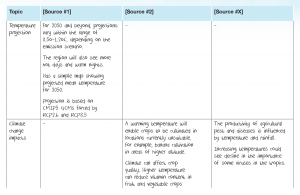Step 3: Find Existing Climate Change Information
Key activities
- Search for relevant studies that have already been carried out
- Revise background about climate change
- Collect traditional knowledge on the topic
- Summarise and synthesise information
Search for relevant studies that have already been carried out
A review and understanding of existing information is essential, even if a new analysis is being undertaken. A summary of previous climate change and other relevant studies provides context for any new work.
Accessing previous relevant studies will likely require some searching at the library or on the internet, as well as making enquiries with relevant stakeholders (including regional organisations and technical experts). There may also be relevant studies that have been carried out on the same subject but in other countries or on a slightly different but otherwise still relevant subject in the country of interest.
Revise background information about climate change
If you are not clear on any climate change concepts or processes it is important to revise background information about climate change to ensure you understand the results of the relevant studies you have identified. Relevant background includes the physical drivers of climate variability, extremes and change and the local climatology including past climate and current observations and trends. A more general understanding of global emissions scenarios, climate models and issues around confidence and uncertainty in model projections is also helpful.
Collect traditional knowledge on the topic
Local communities in the Pacific have considerable knowledge of weather and climate systems relevant to their immediate location based on traditional understanding of how the physical and biological environment interact. Traditional knowledge of this type is critically important to better understanding the physical scientific knowledge underpinning climate change in the Pacific. The practical integration of the two approaches as part of an integrated assessment is often the best way to raise awareness and communicate key climate change information at the local community level.
Summarise and synthesise information
Sort and categorise the information from all sources. Information that is less relevant can be identified and put aside. Focus can then be turned to the relevant information that has been found.
There are many ways to do this, depending on individual preference. One way is to prepare a simple review table. The first column lists topics of interest, and subsequent columns list information by source. As information is collected from each source, notes can be recorded in the appropriate cell.

Carefully record source details. At a minimum, this should include the author’s name, title of the source, year published and URL address for written sources, and the name of the expert if it was a personal communication. Where information is collected at a meeting or workshop, it can be useful for future reference to record the date and location of the meeting.
IMPORTANT: Watch out for misleading information – use only trusted websites, books and papers. Check the validity of sources that are unfamiliar. Try to be as comprehensive as possible – use more than one or two sources.
IMPORTANT: Where possible, always use existing information rather than do new work. If new work does have to be undertaken to generate the required information, use the simplest and most robust method available, based on expert technical advice and guidance material from reputable sources.
Useful resources for finding climate change information include:
- PACCSAP publications, available at pacificclimatechangescience.org
- The Pacific Climate Change Portal at pacificclimatechange.net
- The Pacific Meteorological Desk Partnership at pacificmet.net
- SPC publications, available at spc.int/resource-centre/
- Traditional knowledge collected through the Climate and Oceans Support Program in the Pacific (COSPPac) at http://cosppac.bom.gov.au/traditional-knowledge
CASE STUDY EXAMPLES
NEXT STEP
- If this climate change information is being used as context for a new analysis, go to Step 4: Collect observed climate data
- If this climate change information is being used for risk assessment, go to Step 7: Assess climate change risk
- If this climate change information is being used for awareness raising or another purpose, go to Step 8: Communicate climate change information
